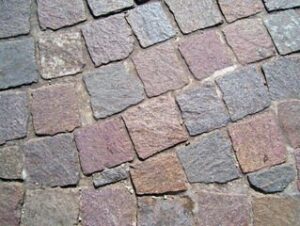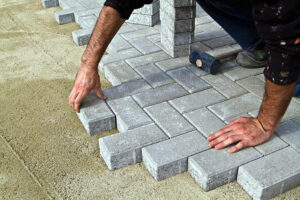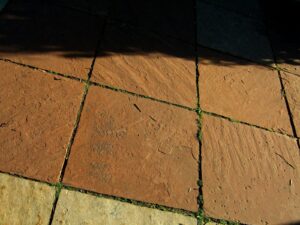Ahhh Spring is in the air. It won’t be long before we are back outside working and playing in our yards. When it is time for a break, lets hop on over to the patio and put our feet up for a while. What you say? No patio or perhaps your patio is in need of a little pick me up. Not to worry, patio construction is not overly complicated and I would like to help you see how selecting certain patio construction materials can help you enjoy your patio to its fullest.
The Beginning
All new patios start with a good base. To achieve this you must first remove some soil from your patio site. This is the excavation phase and probably the most important. No matter the type of patio construction materials, a proper excavation is necessary to ensure a well constructed and lasting patio.
The actual patio surface will determine the depth of your excavation. The patio construction materials beneath your selected patio type will be similar.
Patio Materials
Concrete 4 inch thick + 4 inch Base Material = 8 inch excavation
Pavers 2 3/8- 3 1/8 inch thick + 5 inch Base material = 7-8 inch excavation
Stone (Dry Set) 1 1/2 -2 1/2 inch + 5-6 inch Base material = 7-9 inch excavation

Concrete, whether stamped or traditional is usually poured at 4 inches thick for patio surfaces, if auto traffic is expected than it would be 6 inches. The base consists of a 4″ layer of 3/4 stone which allows for water drainage beneath the patio to help prevent movement and shifting which can and will cause cracks.
Pavers have actually a two step base method. First a 4 inch layer of Item 4 or 3/4 stone is installed. Some contractors prefer 3/4 stone because it drains water more efficiently. This layer is compacted and then a 1 inch layer of stone dust is applied as a setting base for the pavers.
Stone is similar to pavers except for the uneven thicknesses of the stone requires a thicker setting base to accommodate this. Stone may also be applied on top of concrete and this would require a deeper excavation up to possibly 12 inch.
Back to basics
I just wanted to give you an idea of what would be required to start on a new patio and information you may need in making alterations to your patio in the previous section. Most of the selection of patio construction materials you make will be based on your personal preference for a variety of reasons.
Concrete is a time tested favorite. With the new trend being toward stamped concrete. Stamped concrete is poured in the traditional method however the finishing technique involves placing coloring and release powders on to the surface and then imprinting the still plastic surface with rubber mats for a variety of simulated brick and stone surfaces. It is a highly complicated process, requiring a very skilled contractor. Do your research in obtaining a contractor for this type of patio to ensure a job well done.
Traditional concrete is usually finished by dragging a broom across the surface, which creates a lined surface like you see on most commercial sidewalks for traction. The biggest drawback to using concrete, is it probably will crack some where at some time. A good contractor shall work to minimize this by placing control joints at key intervals and positions and putting in a proper compacted base. However the simple nature of the process of placing a huge area of concrete on top of the ground, particularly in cold climates lends to the inevitability of getting some cracks.
Pavers come in all shapes and colors. They were all the rage for years because of this. Pavers are perhaps the most forgiving patio material as they do not crack. They are subject to settling but with a properly prepared compacted base this can be minimized and is also repairable with little notice to the difference between the repaired area and the unrepaired area. The biggest drawback to pavers was that weeds grow between the cracks. Polymeric sand used in new construction helps to prevent this. It can also be placed in an old patio with a little work. Most pavers will fade over time. The sun is a powerful force. All in all pavers are my favorite material here in the Northeast because of their flexibility in being able to move without cracking. The design elements are limitless.
Stone is probably the most difficult and expensive patio construction materials to use. Natural Stone does have an unsurpassed beauty. A well done job is undeniably beautiful. Placing stone on concrete in cold weather climates is tough to keep undamaged because of the limited ability of using control joints and the propensity of water in finding its way through the mortar joints. This type of construction requires a very skilled contractor. Do your research if you go this way. Stone placed in a similar fashion to pavers lends itself to less water and freeze-thaw damage but the uneven thicknesses will show up over time with settlement, this also is repairable with little notice.
water in finding its way through the mortar joints. This type of construction requires a very skilled contractor. Do your research if you go this way. Stone placed in a similar fashion to pavers lends itself to less water and freeze-thaw damage but the uneven thicknesses will show up over time with settlement, this also is repairable with little notice.
DIY or Hire a contractor
Depending on how skilled you are or the size of your project some patio construction could be performed by a do it yourselfer. Just remember proper construction involves removing large amounts of earth and you will need a way to accomplish this, possibly involving renting some equipment. You will also need an area to place the excavated material and it will be a lot.
The patio construction material most suited for a DIY project is probably pavers. Most manufacturer’s provide all type of instruction. If you make a mistake it is usually not that hard to remove some pavers and fix it. Perhaps try a smaller project first and see how it goes.
Stone and concrete jobs, as described before are very difficult and probably should be left to a professional. They have done this many times and know all the tricks and pitfalls. A stone patio on a dry base would probably be the best way to go if you chose to do it yourself with stone.
Hope this helps
There you have it just wanted to give you a little ammunition in choosing your patio construction materials and possible contractors. I think this will also give you a little insight to the process so that if you do hire a contractor you will know a little more about what is going on during the construction. Thanks for visiting. Feel free to leave comment below.
Rick
coolpatiodecor.com
